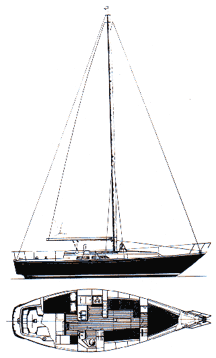About the C&C Landfall 38…
--Blog post written by Bob
C&C was a prominent Canadian boat builder (located in Niagara-on-the-Lake, Ontario) that built its reputation on racers/cruisers. C&C’s Landfall series was their first attempt to build a large production boat with an emphasis on cruising. The Landfall 38, designed by Rob Ball, was first introduced in 1979 and continued in production until 1985--about 250 boats were built over the seven-year production run. S/V Rainy Days (originally named Galatea by the original owner from New Jersey) is hull #230 and was built in the Middletown, Rhode Island plant. I am the second owner, having purchased the boat used in 1986. It was among the last ones produced, as both plants closed down shortly thereafter and the original boatbuilding company (named for George Cuthbertson and George Cassian) went out of business. Today, at least one C&C can still be found in almost every large marina on the Great Lakes and the Chesapeake Bay, while the Landfall series is a relatively rare find.
Statistics
Length overall = 37' 7"
Waterline length = 30' 2"
Beam = 12' 0"
Draft = 5' 0"
Displacement = 16,700 pounds
Ballast = 6,500 pounds lead
Design and Construction
The
Landfall 38's decks are wide and relatively uncluttered (except for the whisker
pole mounted on deck and the fuel and water jugs that I will store on deck
while cruising). The cockpit is T-shaped with a relatively large diameter wheel (36 inches).
The
Landfall 38’s hull is solid fiberglass below the waterline and a balsa-cored
composite above the waterline. The decks are composite balsa-cored construction
for rigidity without adding weight. The deck and hull are fastened together
(using an inboard flange) along with an external teak toe rail.
Below decks
The
forward cabin has a V-berth with teak planking on the sides along the hull and
lots of drawers and cabinets for storing clothes. Just aft of the v-berth cabin
is the main salon with opposing port and starboard settees that could be used
as single berths if needed.
Further
aft along the port side is a very large L-shaped galley (some had a U-shaped galley) with lots of storage
and counter space. A 3-burner stove and oven are located on the port side of
the galley. On the starboard side is a relatively large head (for a sailboat) with
an integral shower stall. Further aft is the owner’s cabin with a good-sized
double quarter on the port side (again with teak planking on the side of the
hull) and a navigation station to starboard. Teak and holly flooring is used throughout the
boat. The wooden bulkheads between the three cabins are constructed from teak-veneered plywood.
Fresh
water storage totals 104 gallons, almost equally divided among three large
molded plastic tanks, one located beneath each settee and one below the
v-berth. The relatively small 15-gallon holding
tank is located beneath the seat in the navigation station.
Auxiliary Power
Auxiliary
power is provided by a Yanmar 30 HP 3HM(F) diesel engine. The engine is tucked in under the cockpit and
has a v-drive transmission. There is engine access through two removable panels in the
quarter berth, removable cabinetry in the area of the companionway steps, and through the starboard cockpit
locker.
There are a number of blogs of other people cruising on a C&C Landfall 38. Wally Bryant is currently cruising in Mexico on S/V Stella Blue, after undergoing an extensive retrofit of his boat over a 10-year period. Canadian sailors, Ross and Beverly Joslin, have sailed their Landfall 38, S/V Raft, throughout the Bahamas and elsewhere. Tony and Andrea Mitchell are cruising their Landfall 38, S/V Irish Melody in the South Pacific.
Thanks for following our blog!
Notes: Some of the
information in this post came from an article written by Jack Horner, a naval
architect and surveyor based in Annapolis, MD.Other Cruisers on a C&C Landfall 38
There are a number of blogs of other people cruising on a C&C Landfall 38. Wally Bryant is currently cruising in Mexico on S/V Stella Blue, after undergoing an extensive retrofit of his boat over a 10-year period. Canadian sailors, Ross and Beverly Joslin, have sailed their Landfall 38, S/V Raft, throughout the Bahamas and elsewhere. Tony and Andrea Mitchell are cruising their Landfall 38, S/V Irish Melody in the South Pacific.
Thanks for following our blog!

The hull isn't solid fiberglass, it's balsa cored (below+above waterline). Unless a few early models were solid FRP? (but #230 isn't an early model)
ReplyDeleteMy boat (hull #230 and a later model made in the Rhode Island plant just before it closed) is solid fiberglass below the waterline.
ReplyDelete